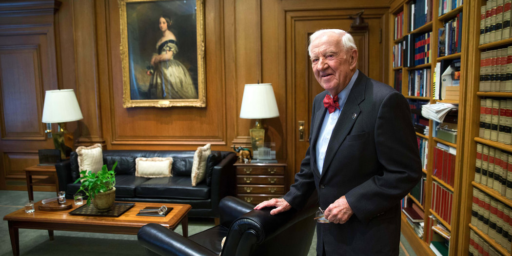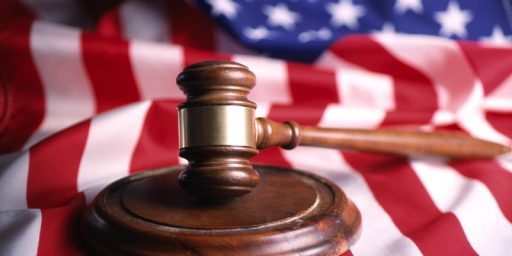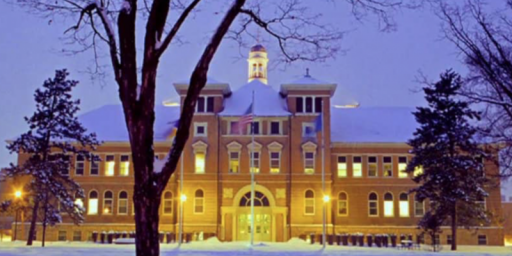SCOTUS Strikes Down Race Discrimination as Cure for Race Discrimination
The Supreme Court, in yet another 5-4 ruling, has decided that discriminating on the basis of race is not a Constitutionally permissible solution to race discrimination. Lyle Denniston:
Concluding its current Term with a historic ruling on race in public policy, the Supreme Court divided 5-4 on Thursday in striking down voluntary integration plans in the public schools of Seattle and Louisville. Chief Justice John G. Roberts, Jr., wrote the majority opinion in the combined cases. Justice Anthony M. Kennedy did not join all of the majority opinion, but joined in the result.
“The way to stop discrimination on the basis of race is to stop discriminating on the basis of race,” Roberts wrote. On the two school plans, the majority found that the districts have “failed to provide the necessary support for the proposition that there is no other way than individual racial classifications to avoid racial isolation in their school districts.”
The Chief Justice, in his oral announcement of the ruling, insisted that the Court was remaining faithful to Brown v. Board of Education in barring public school districts from assigning students on the basis of race. Answering that, Justice John Paul Stevens said in dissent that there was a “cruel irony” in making that claim, because it involved a rewriting of the history “of one of this Court’s most important decisions.” Stevens noted that he joined the Court in 1975, and asserted that “no member of the Court” at that time “would have agreed with today’s decision.”
Whether true or not (and I suspect the latter, given William Rehnquist’s presence on the Court) the passage of 32 years presumably impacts permissible policy. The 14th Amendment rather clearly enjoins discrimination on the basis of race. In various desegregation cases in the 1960s and 1970s, though, the Court carved out what they deemed reasonable exceptions to that policy so long as they were aimed at remedying past discrimination.
Increasingly, though, the Court has applied strict scrutiny to government-sponsored discrimination. In the present cases, the districts were trying to force integration of schools to remedy benign neighborhood settlement patterns. That’s certainly a different thing than trying to remedy decades of state-sanctioned segregation.
Stevens does have a point though. While virtually everyone now agrees with the public policy result, Brown was decided on a peculiar basis. Rather than simply saying Plessy v. Ferguson was wrongly decided in 1896 and was contrary to the plain meaning of the 14th Amendment, the Court instead relied on some social science data showing that kids discriminated against on the basis of race were internally stigmatized and permanently hampered economically by a sense of isolation and limitation. If that rationale still holds as Constitutional doctrine rather than mere dicta, then it’s difficult to see why school districts aren’t within their rights to forcibly integrate students.






interesting, the difference a few years can make..
It was just a few years ago that we were dealing with Grutter v. Bollinger, and Bakke, wherein the court essentially ruled that race SHOULD be a factor, when dealing with admissions… and those, James, were not 32 years ago, but seven years ago.
…..I had just started BitsBlog when Grutter came down… My gosh… 7 years? Oh, well. Anyway;
The cognitive dissonance inherent in Grutter was perhaps fairly well laid out in my objections at the time. As in this case, the key argument it seems to me was whether are not there was a compelling interest of maintaining a “diverse student body”, purely by means of bean counting. I said then…
(aside: Please note that I’m arguing, 7 years ago, as I did yesterday, from the standpoint of exsting definitions… in this case, the Constitution.)
I bring all this up, because it appears to me at first glance of the ruling, that the logic employed in this ruling flies directly in the face of Grutter and, in turn, Bakke. O wonder, then, if we’ll see an overturning of these earlier rulings.
I would take the comments of Mr. Justice Stevens to confirm your suggesion that the court has been steadily reversing its decisions as you point out. I see clearly in this ruling, the logic a comment that I made the day Grutter was handed down:
As a final swipe to the status quo, I will quote Mr. Justice Thomas who quipped:
The logic for the overturning of those earlier rulings I cite, would seem to have been laid in this ruling. You can imagine the smile on my face, that the logic in this ruling, is precisely the logic I laid out seven years ago. The only question remaining in my mind about all of this, is whether or not the technical language of this ruling will overturn such as Bakke and Grutter, given that those are in response to government mandated “diversity” programs, and this one, was supposedly “voluntary”.
James I’m sorry for the length of this one, but it’s nice to be vindicated… Even if it took most of a decade to get there.
I stand corrected on the time factor…. Grutter was June of ’03.
Well, Grutter was decided 5-4 O’Connor has been replaced with Alito, so that presumably has something to do with it.
While I thought Grutter was wrongly decided [see my posts here], there is some difference in considering race along with other criteria in making a subjective decision for college admissions and busing kids out of their communities to achieve integration.
No argument on any of that. After all, there are very few comparisons that are equal on all points. The point I’m making, however, is not the specifics and the logistics involved, but the logic behind implementing them.
Your point about Alioto, is well taken. Perhaps what we are witness to, here is the best argument to come along in a lot of years, of the difference that a different President making Supreme court appointments, can make.
And granted that I am playing kindergarten Supreme Court observer, here, but it also points vividly at the fallibility of the high court. After all, these rulings, and these philosophies on which these rulings are based, which so apparently are a direct opposites, cannot both be constitutional. It is a logical impossibility.
Seems to me and one of my classes, years ago, we had a similar discussion about Dred Scott, and whether not that ruling was, in fact, constitutional.
Yup. Dodd and I talked about that on OTB Radio Monday, in fact.
Stevens says that the court should leave policy decisions to the legislative branch – at least when he disagrees with them